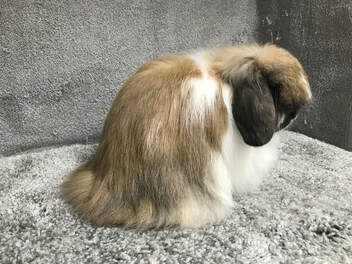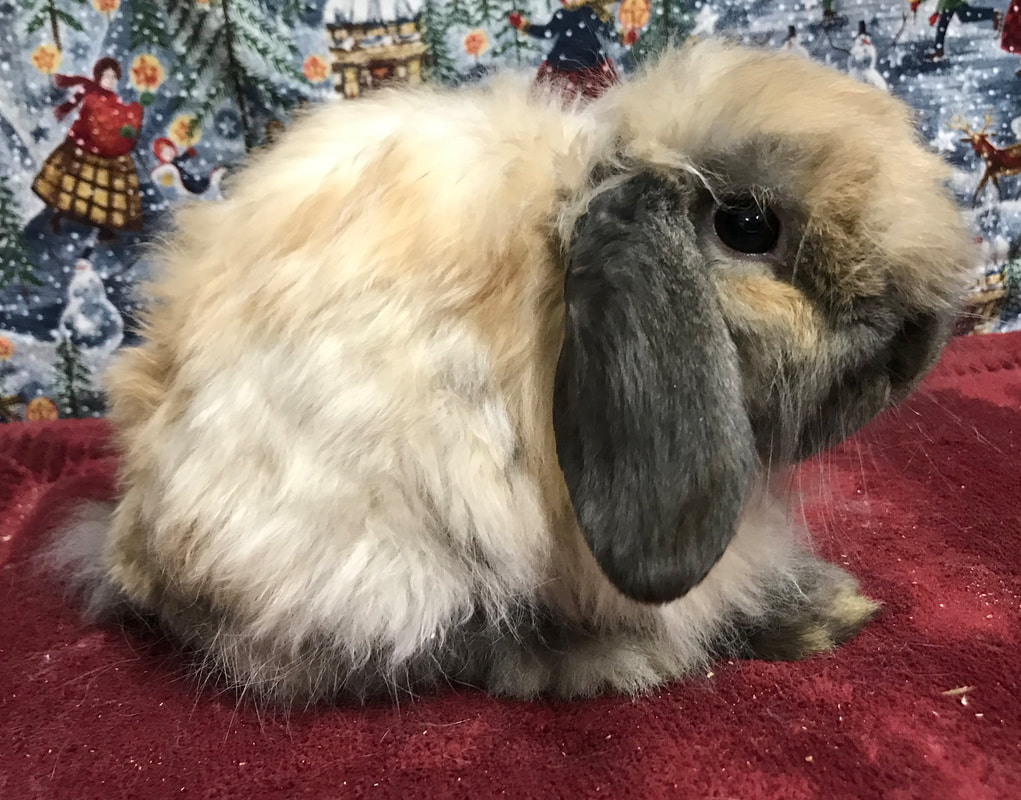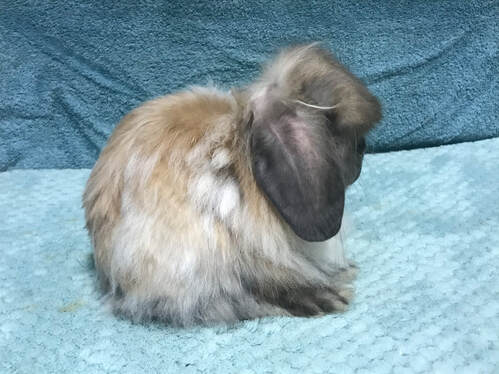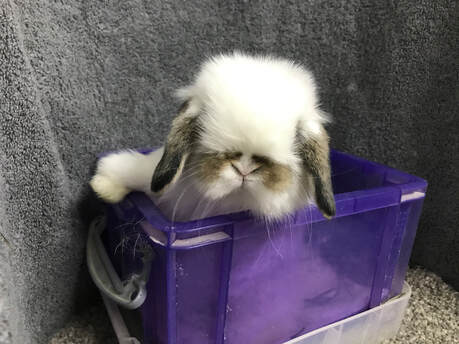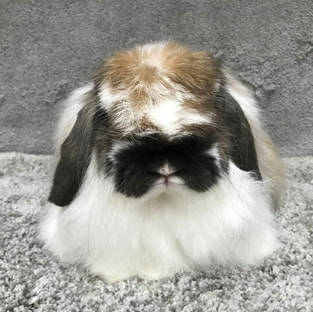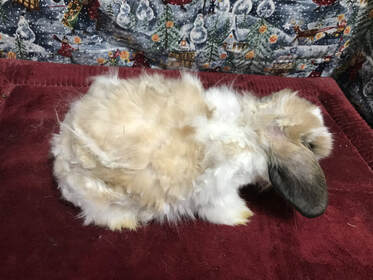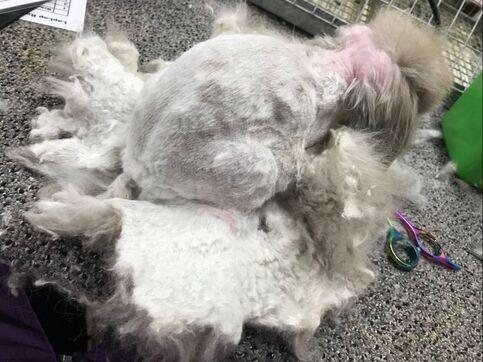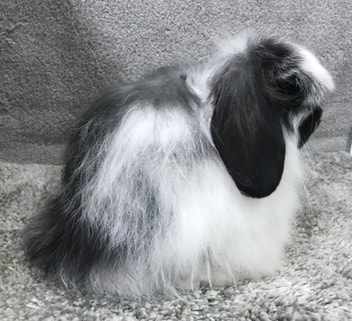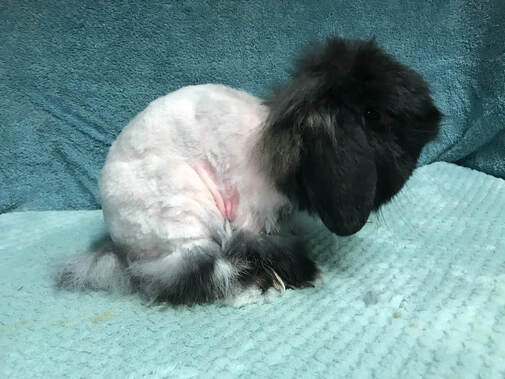GROOMING THE AMERICAN FUZZY LOP
A couple of 8 week old fuzzies just after plucking! At this age not only does their coat look atrocious their ears look a mile long!
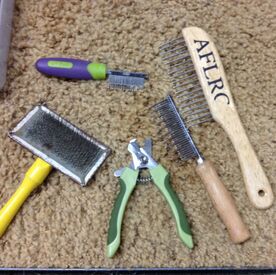
Basic Grooming of the American Fuzzy Lop
(If you are a YOUTH under 10 or 12 you should show this to a helpful responsible adult. It takes time to learn these skills and if there are two of you it may go easier!)
You just brought home that 8 week old adorable fuzzy baby! Now what?
You will need the following tools: AFL Comb (poodle comb), slicker brush, medium comb, super fine flea comb, and scissors, possibly a good pair of dog clippers with an assortment of blades. Additionally you will want corn starch (from the grocery store) , a hair grabber mitt (for your own clothes), a grooming mat or carpet, good lighting, nail clippers and patience, and did I mention patience!
There are several stages to an AFL coat. Not all AFL’s go through all the stages nor do they hit a stage at a specific age in their life. There are lots of variables, many of which may not be identifiable. The best AFL coats are undeniably a result of great genetics, resulting from persistent selection for ease of care. In all cases as the AFL matures, the coat improves and as an adult requires less grooming. At that time the grooming requirements will depend on the showing or breeding status of the animal. As an AFL owner expect to experience the BIG BABY MOLT which transforms into a Junior coat. The Junior coat eventually becomes a mature coat or senior coat. Each successive transformation is easier to manage.
Most beginners to the American Fuzzy Lop breed are not lucky enough to get one of those ‘shake and show’ coats the first few times around. In fact most beginning breeders start with a fuzzy Holland and struggle with some of the most difficult long wooly coats. I will try to help you learn to groom any of these coats, while helping you to appreciate the truly beautiful and easy to care adult pure American Fuzzy Lop coat.
At four weeks of age the young AFL begins to show an adorable fluffiness, making his head look wide, his body chubby and round and those little ears are lopping or not! Nothing, but nothing is cuter! By the time they are six weeks old the fluff is getting longer, may be picking up hay and debris and probably trapping feces under the tail! This is about weaning time, and a little bit of handling, assuring a clean ‘butt’ and maybe introducing a light brushing will introduce the baby to some of the necessities of his life.
By eight weeks of age, it becomes mandatory to attend to the young AFL’s coat. All too often we are too busy to pay much attention to these weanlings. A little time here will go a long way as the baby coat is preparing to depart the body! You will first notice little knots behind the head near the ears (use flea comb for removal). In my experience even the best coated babies will have a time where the nape of the neck mats and drops coat to the point of becoming pink and bald. I use a drop of Ivomec on the skin – I’m not sure why it works – I have never seen ‘fur mites’ and I don’t think I have any other parasites…. And maybe it is a coincidence, but shortly after the application of Ivomec, the coat covers the pink and grows back healthy.
In any case, at this time the baby coat will begin to molt. Molting mean the old coat is loosening and the new coat is emerging. There are several different scenarios that accompany this molt. Some of the best coated babies, usually torts, will gradually lose the soft undercoat which is easily brushed or plucked out and some even retain baby guard hairs giving length to the coat while the undercoat regrows, giving density and length to the junior coat. In this case, concurrently the guard hairs become coarser and you have a phenomenal junior coat. More often, between 8 – 12 weeks, much of the entire coat loosens from the body and either forms mats, if ignored, or brushes out in clumps with varying degrees of difficulty. Too often these mats grow quickly and almost overnight you find clumps on the shoulders, hindquarters and along the sides. While it is frustrating to find this, there are reasonable solutions to mat removal and I will go into detail in part 2. In the worst case scenario the mats form at the skin, are tight, and the coat hasn’t loosened from the body enough yet and the mat removal is painful and painstakingly slow. Most of the time, this specific situation is on a fuzzy Holland, without generations of selective breeding for easy care coats. Certainly not all fuzzy Hollands go through their molt this way.
If you are new to the breed I am sure you have every intention of being a dedicated groomer and by gosh, your baby is not going to get matted! Routine grooming will keep you on top of the game. Disciplined thoroughness is necessary. Every square inch of the body needs to be brushed out. If you find a mat (and you will) you must get through it now – do not put it off until next time as it will grow exponentially! Those loosening hairs will wrap themselves around new coat or guard hairs and tighten up.
TECHNIQUE First and foremost, familiarize your bunny to the grooming table and routine BEFORE it is a desperate situation. Place him on the grooming mat. Hold him close to your body and at the table lift the coat near the hindquarters to start brushing it down in layers. With a youngster I may use the large AFL comb (poodle comb), but I might use the middle sized comb or maybe even the slicker brush. With a light and flicking motion comb/brush the coat outwards. You should be able to see the skin each time you finish a layer. You will work upwards from the table, layering the brushed coat down. As the coat begins to loosen in its molt you will find the coat is being removed by this flicking motion. On a typical baby, without encountering much matting you will go through this process. starting at the table, approximately three times per side of the body, once at the hips, once on the midsection/rib area and once in the shoulder area. Then you face the bunny the other direction and repeat the process. Ideally you now can proceed to the chest. I hold the head up gently and beginning near the table layer the coat as before, combing or brushing it in a specific and disciplined pattern. With that completed you will flip the bunny to its back and holding it like a baby in your arms, brush out the tail and genital area. Check the tummy too. Five minutes on an unmatted and cooperative youngster will do the trick. Plan on an hour if you are seriously removing matted coat from a molting bunny.
Easy, peasy Right?! This is usually easier said than done. Sometimes that cute little adorable AFL has opinions and lack of patience. Gentle persistence will win out and you must win out and thoroughly brush the entire bunny. Again if you can familiarize your weanling to this process before the BIG BABY MOLT the easier it will be on both of you.
(If you are a YOUTH under 10 or 12 you should show this to a helpful responsible adult. It takes time to learn these skills and if there are two of you it may go easier!)
You just brought home that 8 week old adorable fuzzy baby! Now what?
You will need the following tools: AFL Comb (poodle comb), slicker brush, medium comb, super fine flea comb, and scissors, possibly a good pair of dog clippers with an assortment of blades. Additionally you will want corn starch (from the grocery store) , a hair grabber mitt (for your own clothes), a grooming mat or carpet, good lighting, nail clippers and patience, and did I mention patience!
There are several stages to an AFL coat. Not all AFL’s go through all the stages nor do they hit a stage at a specific age in their life. There are lots of variables, many of which may not be identifiable. The best AFL coats are undeniably a result of great genetics, resulting from persistent selection for ease of care. In all cases as the AFL matures, the coat improves and as an adult requires less grooming. At that time the grooming requirements will depend on the showing or breeding status of the animal. As an AFL owner expect to experience the BIG BABY MOLT which transforms into a Junior coat. The Junior coat eventually becomes a mature coat or senior coat. Each successive transformation is easier to manage.
Most beginners to the American Fuzzy Lop breed are not lucky enough to get one of those ‘shake and show’ coats the first few times around. In fact most beginning breeders start with a fuzzy Holland and struggle with some of the most difficult long wooly coats. I will try to help you learn to groom any of these coats, while helping you to appreciate the truly beautiful and easy to care adult pure American Fuzzy Lop coat.
At four weeks of age the young AFL begins to show an adorable fluffiness, making his head look wide, his body chubby and round and those little ears are lopping or not! Nothing, but nothing is cuter! By the time they are six weeks old the fluff is getting longer, may be picking up hay and debris and probably trapping feces under the tail! This is about weaning time, and a little bit of handling, assuring a clean ‘butt’ and maybe introducing a light brushing will introduce the baby to some of the necessities of his life.
By eight weeks of age, it becomes mandatory to attend to the young AFL’s coat. All too often we are too busy to pay much attention to these weanlings. A little time here will go a long way as the baby coat is preparing to depart the body! You will first notice little knots behind the head near the ears (use flea comb for removal). In my experience even the best coated babies will have a time where the nape of the neck mats and drops coat to the point of becoming pink and bald. I use a drop of Ivomec on the skin – I’m not sure why it works – I have never seen ‘fur mites’ and I don’t think I have any other parasites…. And maybe it is a coincidence, but shortly after the application of Ivomec, the coat covers the pink and grows back healthy.
In any case, at this time the baby coat will begin to molt. Molting mean the old coat is loosening and the new coat is emerging. There are several different scenarios that accompany this molt. Some of the best coated babies, usually torts, will gradually lose the soft undercoat which is easily brushed or plucked out and some even retain baby guard hairs giving length to the coat while the undercoat regrows, giving density and length to the junior coat. In this case, concurrently the guard hairs become coarser and you have a phenomenal junior coat. More often, between 8 – 12 weeks, much of the entire coat loosens from the body and either forms mats, if ignored, or brushes out in clumps with varying degrees of difficulty. Too often these mats grow quickly and almost overnight you find clumps on the shoulders, hindquarters and along the sides. While it is frustrating to find this, there are reasonable solutions to mat removal and I will go into detail in part 2. In the worst case scenario the mats form at the skin, are tight, and the coat hasn’t loosened from the body enough yet and the mat removal is painful and painstakingly slow. Most of the time, this specific situation is on a fuzzy Holland, without generations of selective breeding for easy care coats. Certainly not all fuzzy Hollands go through their molt this way.
If you are new to the breed I am sure you have every intention of being a dedicated groomer and by gosh, your baby is not going to get matted! Routine grooming will keep you on top of the game. Disciplined thoroughness is necessary. Every square inch of the body needs to be brushed out. If you find a mat (and you will) you must get through it now – do not put it off until next time as it will grow exponentially! Those loosening hairs will wrap themselves around new coat or guard hairs and tighten up.
TECHNIQUE First and foremost, familiarize your bunny to the grooming table and routine BEFORE it is a desperate situation. Place him on the grooming mat. Hold him close to your body and at the table lift the coat near the hindquarters to start brushing it down in layers. With a youngster I may use the large AFL comb (poodle comb), but I might use the middle sized comb or maybe even the slicker brush. With a light and flicking motion comb/brush the coat outwards. You should be able to see the skin each time you finish a layer. You will work upwards from the table, layering the brushed coat down. As the coat begins to loosen in its molt you will find the coat is being removed by this flicking motion. On a typical baby, without encountering much matting you will go through this process. starting at the table, approximately three times per side of the body, once at the hips, once on the midsection/rib area and once in the shoulder area. Then you face the bunny the other direction and repeat the process. Ideally you now can proceed to the chest. I hold the head up gently and beginning near the table layer the coat as before, combing or brushing it in a specific and disciplined pattern. With that completed you will flip the bunny to its back and holding it like a baby in your arms, brush out the tail and genital area. Check the tummy too. Five minutes on an unmatted and cooperative youngster will do the trick. Plan on an hour if you are seriously removing matted coat from a molting bunny.
Easy, peasy Right?! This is usually easier said than done. Sometimes that cute little adorable AFL has opinions and lack of patience. Gentle persistence will win out and you must win out and thoroughly brush the entire bunny. Again if you can familiarize your weanling to this process before the BIG BABY MOLT the easier it will be on both of you.
Basic Grooming of the AFL Part 2
One day you will wake up and OVERNIGHT your young American Fuzzy Lop has mats and clumps! This is it – the BIG BABY MOLT. Console yourself – this has to happen. That soft baby coat has to shed out to allow the junior coat to emerge. This may be the most difficult molt in an AFLs life. Longtime breeders have two or three methods that they employ, often depending on the particular youngster and the individual coat. Especially in the summer, trimming the entire coat with scissors to about an inch in length eliminates the need for regular grooming sessions for several weeks. Other breeders ‘pluck’ out the loose baby coat. This results in a similarly short coat, which allows the junior to grow up without frequent grooming sessions. Some breeders will opt to groom a youngster weekly, picking through a few mats, and generally maintaining a showable coat.
If your AFL is a pet, I highly recommend just trimming it down with scissors at about 10 – 12 weeks and let the coat grow out. They will look pretty awful at first! You will still need weekly grooming sessions as that baby coat still needs to come out and it needs to be removed, but there is far less of it and it is much less likely to become matted and painful to remove. To trim a long haired bunny down, use basic sharp scissors. Keep the blades parallel to the skin and trim at about an inch. Often there is a demarcation where the new coat is coming in – That is a good measure to go by. Don’t worry if it looks pretty choppy. These coats grow fast, and the difference between a good haircut and a bad one is a week at most! And in three weeks you will be amazed at how thick and even it looks! Again, the higher quality AFL the more successful this process is, but especially with a poorly coated youngster, this is often the most convenient way to go.
The other option, which I have recently been using more often, is 'shaving' the baby down. The bunnies never have a reaction to the clippers, unlike dogs or horses. I use Oster clippers, although I know there are other good animal grooming clippers on the market. I use a fine blade - a #15 is my 'go to' size. With this you are able to get under mats pretty easily. You will clip in the direction that the coat grows. Don't go 'against the grain' as that might be too short (although can be necessary in a very matted to the skin individual). Keep your blades cool (blade cooling spray). In areas where there are few or no mats by going with the coat growth direction you will leave and inch or more. In areas where the bunny is very matted you may be to the skin or leaving only 1/4 of an inch. In all cases as the coat grows out it will even itself out. I don't shave the head or chest, and if I can easily remove mats on the belly that is also left unshaved. The most difficult area is under the tail. Do that last. Make sure the clippers are cool, Be careful and come around the side of the hips toward the genitals. The specific genital area is also left unshaved.
If your Junior is a show prospect, most AFL breeders will “pluck” out the baby coat. The trick here is to know when to do it. Plucking is essentially grasping a few loose hairs and quickly pulling them out of the coat. It sounds painful, but it isn’t. The youngster often reacts very mildly the first few plucks, and then almost ignores what is going on. If the plucking is pulling too hard, then the coat is not ready to be plucked. We have found the area on the back and near the neck to be the first to loosen sufficiently to pluck. We have also found it may take more than one session, as the whole body may not be ready to pluck at the same time. Be diligent and methodical.
The first baby we ‘plucked’ looked like it had a skirt after the first session. The entire neck and back and down the sides plucked readily, but the lower coat was just not ready! A few days later we were able to complete the job. Plucking is usually necessary between 8 and 12 weeks. With any luck at all, that promising junior will have a thick and showable coat by 4 or 5 months.
If you want to groom through the BIG BABY MOLT, you may find it possible to simply groom through this transition. This will require careful and diligent grooming. You will be regularly working through some minor matting and may be able to save enough coat to let it transform into the Junior coat relatively seamlessly. However even experienced breeders know that this is a tricky proposition. There is no set timetable for the ‘blowing of the baby coat”, especially if the baby coat seems pretty tight and growthy. The best AFLs will have texture from the guard coat coming through by 4 months and if they retain some of the baby coat they will have that “double coat’ (the coat that is destined to molt out plus enough new coat coming in to present a thick and luxurious coat). Be aware however, that if that baby coat decides to blow, it can take even the new coat with it.
The Payoff! Most of us have been there, done that! Convention or Nationals is coming up and your promising junior coats looks really good! You pay your money and get ready to go – three days before departure and POOF that baby coat just blew, taking the junior coat with it! If you are lucky, it may wait to blow until the week after Convention, AFTER that promising Junior took his class….
|
|
This is a 10 week old youngster with a very easy coat. He was plucked at 7-8 weeks and is already sporting a cute junior coat.
|
TACKLING THE MAT
(taken from a messenger conversation, while mentoring a newbie)
Responsible AFL breeders would not breed the kind of coat that mats continually. It is a nightmare for you and for anyone who gets offspring that might have the same coat. The worst coats I have had are the ones that 'web' at the skin, but the coat is not letting loose as it should in a molt
That being said, I have one AFL in the barn now that 'felts' his coat. That is pretty much the same thing except that it is not really tight to the skin as the coat that is felting is loose and coming out. This buck is just over a year old and in January he felted so badly when it came off he was literally naked and pink over his haunches.
But to more directly answer your question. I would cut the coat off at somewhere safe - say an inch from the skin or even 1/2 inch if you are careful. Obviously you will need sharp scissors, good lighting, a little confidence and a little patience! The scissors are always parallel to the skin, curving around the structure of the rabbit. You can pull a chunk of mat up a bit and snip it off - As you get closer to the skin you can use a 'slicker' brush - the flat little brush that looks like a wool carder. At this point brush the top of the mat as vigorously as possible and this clip off all the hairs that are sticking up. Start slowly to build your confidence and see how it works. Eventually you should be able to see the skin.
Of course the end result will look terrible at first, but remember it is only about two weeks from a bad haircut to a good one! Also as it grows out you can use your shears and trim it a little more even. Recently I have taken a good pair of dog clippers with a fairly fine blade and shave the rabbit. It might be your best bet. The grow out period is still slow, but it is pretty even. And once it starts growing, groom, groom, groom! You have to stay ahead of the mats, or you will be back in the same predicament again.
(taken from a messenger conversation, while mentoring a newbie)
Responsible AFL breeders would not breed the kind of coat that mats continually. It is a nightmare for you and for anyone who gets offspring that might have the same coat. The worst coats I have had are the ones that 'web' at the skin, but the coat is not letting loose as it should in a molt
That being said, I have one AFL in the barn now that 'felts' his coat. That is pretty much the same thing except that it is not really tight to the skin as the coat that is felting is loose and coming out. This buck is just over a year old and in January he felted so badly when it came off he was literally naked and pink over his haunches.
But to more directly answer your question. I would cut the coat off at somewhere safe - say an inch from the skin or even 1/2 inch if you are careful. Obviously you will need sharp scissors, good lighting, a little confidence and a little patience! The scissors are always parallel to the skin, curving around the structure of the rabbit. You can pull a chunk of mat up a bit and snip it off - As you get closer to the skin you can use a 'slicker' brush - the flat little brush that looks like a wool carder. At this point brush the top of the mat as vigorously as possible and this clip off all the hairs that are sticking up. Start slowly to build your confidence and see how it works. Eventually you should be able to see the skin.
Of course the end result will look terrible at first, but remember it is only about two weeks from a bad haircut to a good one! Also as it grows out you can use your shears and trim it a little more even. Recently I have taken a good pair of dog clippers with a fairly fine blade and shave the rabbit. It might be your best bet. The grow out period is still slow, but it is pretty even. And once it starts growing, groom, groom, groom! You have to stay ahead of the mats, or you will be back in the same predicament again.
